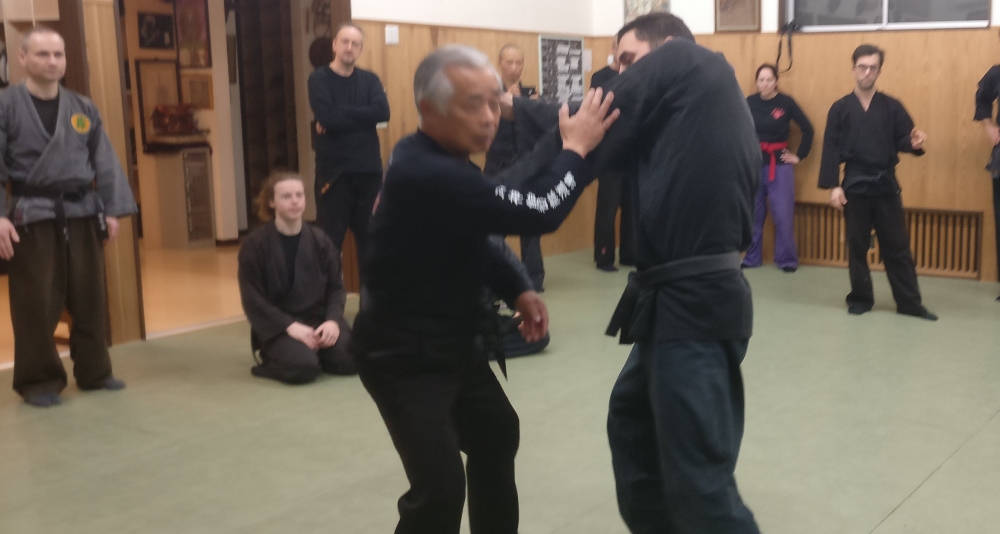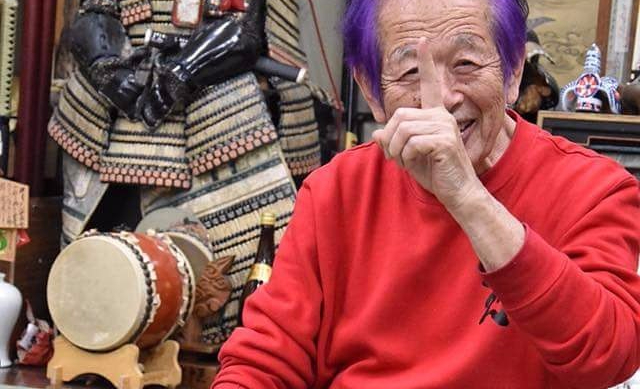From Shiro Kuma by kumafr

- http://shinden-ediciones.com/es/14-bujinkan-ninjutsu
- 折る, Ori(oru): o break; to fracture; to break off; to snap off; to fold; to bend
From Shiro Kuma by kumafr

From Shiro Kuma by kumafr
 These days, this is precisely the feeling I have when training at the Honbu. When skydiving in free fall, you have this incredible feeling of falling within your fall. It is like being into a vortex. The fall seems infinite like falling into an endless fractal. If you had the chance to experience it, you know what I mean. Speed keeps increasing. And you feel you are falling inside your fall until you reach terminal velocity.
These days, this is precisely the feeling I have when training at the Honbu. When skydiving in free fall, you have this incredible feeling of falling within your fall. It is like being into a vortex. The fall seems infinite like falling into an endless fractal. If you had the chance to experience it, you know what I mean. Speed keeps increasing. And you feel you are falling inside your fall until you reach terminal velocity.
Kūkan is like this; it is part of Ūchū, the Universe. (1)(2) Flow with this natural aspect and be one with Kūkan. If you think you can influence the universe, you’re mistaking! You can feel Jūryoku, gravity, on Earth (Chi level), but it exists everywhere in the whole universe (Ten). Being one with the Kūkan, Tori is in control (Jin level). That is the Tenchijin of 2018! (3)
There is a broad relationship between Humanity and Kūkan. Sensei said “Ningen to Kūkan Tsunagaru,” “humanity and space are connected.” (4)(5) When you connect yourself to your own inner Kūkan, you are part of the whole. The Waza are only a means to reach perfect control. As everything is linked in the universe, we just have to use this feeling and move freely. Nothing that we do is relevant, the only thing that matters is the natural flow. Sensei doesn’t do any Waza, he only controls. Control applies to the attacker, but also to the situation, space, and to yourself. If you can control your space, then the rest is natural, because you are moving in harmony with the forces of the universe.
Kūkan is the space between, inside, around Tori and Uke. It is only the place to be. Connected to Kūkan, we are moving into the natural and powerful flow surrounding us. Our intentions, our willingness to do something hinder the natural expression of Life. Hatsumi Sensei does his movements without thinking. He has no intent and is always in phase with the universe. He lets things happen. But Uke trapped in the “I want to attack,” blinded by his intents, cannot see his defeat coming. By not fighting, “Tatakai Wa Janai,” you are one with all things and Uke is your toy. (6) That is why the Bujinkan system is about peace, not war.
I love Sci-fi, and my last sentence reminded me of the end of the book “2001, a Space Odyssey” by Arthur C. Clarke. “and the star child understood the universe was his toy.”
That is what the Dai Shihan must do: play with the universe.
This year is Mutō Dori with an emphasis on justice and peace. Phil Legare on his blog wrote: “I asked Sōke if he had any instructions or advice for the Dai Shihan for the new year 2018. He said, Justice and Peace. Sensei wishes all Dai Shihan to bring about Justice and Peace in their own countries. He noted that we now have Dai Shihan in 55 countries around the world and more all the time. Sōke said that each Dai Shihan must figure out their way forward with Justice and Peace. He hopes they will foster the same goodwill within their own countries and in their groups. Honbu training is still Mutō dori, Control, and No power for each, as before. But there is also an emphasis on the five virtues of the Buddha: the Gojō.” (7)
“Then he [The Star Child] waited, marshalling his thoughts and brooding over his still untested powers. For though he was master of the world, he was not quite sure what to do next. But he would think of something.” ― Arthur C. Clarke, 2001: A Space Odyssey
_____________________
1. 空間, Kūkan: Space. Space is the boundless, three-dimensional extent in which objects and events occur and have relative position and direction. Physical space is often conceived in three linear dimensions, although modern physicists usually consider it, with time, to be part of a boundless four-dimensional continuum known as spacetime.
2. 宇宙, Ūchū: the universe. The universe is commonly defined as the totality of everything that exists, including all matter and energy, the planets, stars, galaxies, and the contents of intergalactic space. Definitions and usage vary, and similar terms include the cosmos, the world, and nature.
3. 人間, Ningen: a human being; person; man; mankind; humankind
4. 繋がる, Tsunagaru: to be tied together; to be connected to; to be linked to; to be related to
5. 戦いわじゃない, Tatakai Wa Janai: There is no fight.
6. 重力, Jūryoku: Gravity, is a natural phenomenon by which physical bodies attract with a force proportional to their masses. Gravitation is most familiar as the agent that gives weight to objects with mass and causes them to fall to the ground when dropped. Gravitation causes dispersed matter to coalesce, and coalesced matter to remain intact, thus accounting for the existence of the Earth, the Sun, and most of the macroscopic objects in the universe.
7. The Gojō are:
滅の不施, Fumetsu no Fuse, endless giving
真道の持戒, Mamichi no Jikai, awareness, right path of self-justice
自然の忍にく, Shizen no Ninniku, perseverance, forbearance
光明の悟り, Komyō no Satori, the light of enlightenment
自然の超越, Shizen no Choetsu, natural transcendence
From Shiro Kuma by kumafr

DISCLAIMER: COMPLEX CONTENT
I have not been in the dōjō for three months, and I have the feeling that Sensei’s movements gained in subtlety. How can it be possible? I am amazed. After class last Friday, I spoke with Liz, a Canadian resident about it and she agreed with me.
I will not detail here what he does because every one of his moves is the expression of high-level Mutō Dori. It is beyond explanations.
Sensei controls his Uke from the very start, and all along the movement. When asked to share what he felt, Duncan said: “Sensei controls me at the very moment he calls me to attack him.” There are no more Waza, only natural adaptive movements.
But his teachings are also getting much more profound. And I want to share some of his lessons from Sunday here. I will give you a few keys to understand, but I will not try to explain them. You can share what you got from it, later in the comments.
Sensei introduced the class by speaking about 悟, Satori. (1) He said the Kanji contains three parts: Kokoro (2), five (3), mouth (4). This new sanshin links the Gojō (5) to the Gogyō. Understanding that, he said, is the goal of the Dai Shihan.
Before I expose the Gojō, I want to explain what a Dai Shihan is in today’s Bujinkan. I heard many people being critical about this evolution of Sensei’s vision. First, once again, Sensei does what he wants and if you are unhappy, then shut up or go away. Second, during the last class Sensei said that with the Mutō Dori of 2018, the real Budō was beginning. He noted that the Dai Shihan are entering the Shōden level of Mutō Dori. That means that we are only beginning to scratch the surface of a new dimension of Budō. Dai Shihan sounds much better than Ōkudo (old beginner), don’t you think?
The Gojō are the five virtues of Confucianism. (6)
In “Advanced stick fighting” (48), Hatsumi Sensei lists the Gojō as:
Confucianism defines them also as (same order):
Sensei has been using the verb Tsunagaru (to be connected to), a lot these days. (9)
So, the mission of the Dai Shihan this year is to “connect” the Gojō and the Gogyō, through Satori (Kokoro, Go, Kuchi).
I hope the next classes will shed some light on how to achieve that. Because right now, I am lost. I wish I were a Satori (10), a monster that can read minds.
Anyway, next Sunday is the first Buyukai meeting at Hana. I guess Sensei will give us the direction to follow during this year. (11)
Ganbatte! (12)
___________________________
1. 悟, satori: comprehension; understanding; enlightenment; spiritual awakening
2. 心, Kokoro: heart, mind, spirit
3. 五, go: 5
4. 口, Kuchi, mouth, gate, opening
5. 五常, gojō: the five cardinal Confucian virtues (justice, politeness, wisdom, fidelity, and benevolence)
6. More on Confucianism: https://en.wikipedia.org/wiki/Confucianism
7. The Five Constants are:
Rén (仁, benevolence, humaneness);
Yì (義/义, righteousness or justice);
Lǐ (禮/礼, proper rite);
Zhì (智, knowledge);
Xìn (信, integrity).
8. In a recent post, Duncan lists the Gojō as being:
滅の不施, Fumetsu no Fuse, Everlasting giving
真道の持戒, Mamichi no Jikai, Vow of the true way
自然の忍にく, Shizen no Ninniku, Natural resolve
自然の超越, Shizen no Choetsu, Transcendence of nature
光明の悟り, Komyō no Satori, Illumination of the awakening
9. 繋がる, Tsunagaru, to be tied together; to be connected to; to be linked; to be related to
10. 覚, satori: folklore monster that can read minds
11. Since January 2018, the Buyukai replaces the Shidōshikai. The new organization is now accessible to any practitioner. The first Buyukai meeting will take place at Hana. That is the usual restaurant in front of the old Honbu. Lunch begins at 2 pm after Sensei’s class.
12. A Personal message to Phil. So? What do you think?
From Shiro Kuma by kumafr

I wrote many times about Japan being the country where one makes mistakes.
I arrived Thursday in Japan and made the first one on arrival. That made me think about Ishiki, awareness. (1)
Before I go further on the philosophical lesson learned, let me tell you the story.
Landing in Narita in the afternoon, I was happy to be there. After buying the yen, getting a wifi router, and a bus ticket to Kashiwa, I went for a smoke (yes, I know it’s terrible, but that is not the point here).
With my suitcase in tow and my small backpack, I went to the designated smoking area located outside the building. I let my luggage outside and went into the booth. A few emails needed my attention, and I answered them. Having finished, I went for a coffee.
Fifteen minutes later I felt that something was missing. My suitcase was still outside the smoking booth.
When this happens in any other country, you panic. But not here. Japan is so safe that nothing can go wrong. As I didn’t want to spill my coffee, I walked calmly to my luggage, and it was waiting for me. I was not even relieved as I was sure it would be there. And that is what I call my mistake.
In the “Lucifer Principle” (2), Howard Bloom explains that when not in danger, any species will die. In short, we only survive because there is a risk of dying. When potentially nothing is threatening you, you lower your defences, and you die.
In my story, the opposite happened. My “Ishiki” level was close to zero. Knowing that Japan is safe, I did something that I wouldn’t do in any other country.
The first lesson I learned is that, even when in a safe environment, you have to be ready for action. For a martial art practitioner, Ishiki must be a permanent state of mind. And not something you activate once in a while. It doesn’t mean you have to become paranoid; it means that you have to be having a permanent awareness.
See that as the “black swan” of Bujinkan.
“The black swan theory is a metaphor that describes an event that comes as a surprise, has a significant effect, and is often inappropriately rationalized after the fact with the benefit of hindsight.
It comes from an ancient saying which presumed black swans did not exist until we discovered them in Australia.”
In short, it is not because something never happens, that it will not happen.
In martial arts, we train to be ready for anything. Friday night I met my friend Christophe Ayen (French Dai Shihan), and I told him my little adventure. He said, “I know what you mean.” I looked at him, and he continued. “Last week I was training at the Honbu with Noguchi Sensei when he got an urgent phone call. He had to go. He came to me and said Christophe can you please finish the class? He went, and I finished the class in English, even though I don’t speak English!”.
You can use Ishiki at any moment inside or outside of the dōjō. Don’t let your awareness down only because you feel safe. Always be ready so that, as Takamatsu sensei said, “there will be no surprise.” Banpen Fugyō.
The second lesson is that smoking is terrible. But that I already knew.
___________________
PARIS TAIKAI 2018 JULY 13th to 15th…
Read MoreFrom Shiro Kuma by kumafr

In class, Hatsumi Sōke was speaking of Mutō Dori. In one of his book, he explains the concept of Mutō Dori. The advanced level of Mutō Dori is entirely different from beginner’s level. It is about having the courage to face the opponent even if it means death for us. He added that when Uke attacks, we must “Yokeru Janai”, not avoid the attack. (1) That is a counter-intuitive move, and you have to train a lot to become able to do it.
Anyone facing a threat will try to avoid it. By not avoiding it, you create doubt in the attacker’s mind. And any doubt created is forcing Uke to think. When you think you put yourself out of the realm of “natural movement”.
Often, when we watch the Sakki test, we know before the cut if the receiver will dodge the blade or not. When you can see the examinee thinking, you know that he is going to be hit. But at one point he lets go, and his mind is at peace, the body reacts by itself. When it happens, it is always a beautiful moment to watch.
You should have the same attitude during the fight. Do not think, show no intent, and “play” with the opponent as if his actions are none of your concern. When you reach this level of Mutō Dori, you move in a natural way that Uke cannot understand until it is too late.
Sensei often speaks of Amo Isshun no Tamamushi. (2) This was the case yesterday.
If you trap a bee in your hands but let enough space, it will not sting. To be honest, even if I never tried, I know it works. During the fight, this is the same. You have to give enough space to Uke so that he doesn’t feel threatened by your movements. Your moves must be soft, slow, and not show any strength.
Hide your intent. As Sōke said, “if you don’t know what you are doing next, how do you want Uke to read your actions?
“Mutō Dori, Yokeru Janai, and Amo Isshun no Tamamushi”. That is the new Sanshin of 2017. Develop it to get to your next level of progression.
___________________
1. 避けるじゃない, do not avoid (physical contact with)
2. Amo Isshun no Tamamushi: 中一瞬 の 吉丁虫. 中 amo: centre, inside, during. 一瞬 isshun: one moment. 吉丁虫 tamamushi: jewel beetle
33% OFF at http://www.budomart.com until December 6th